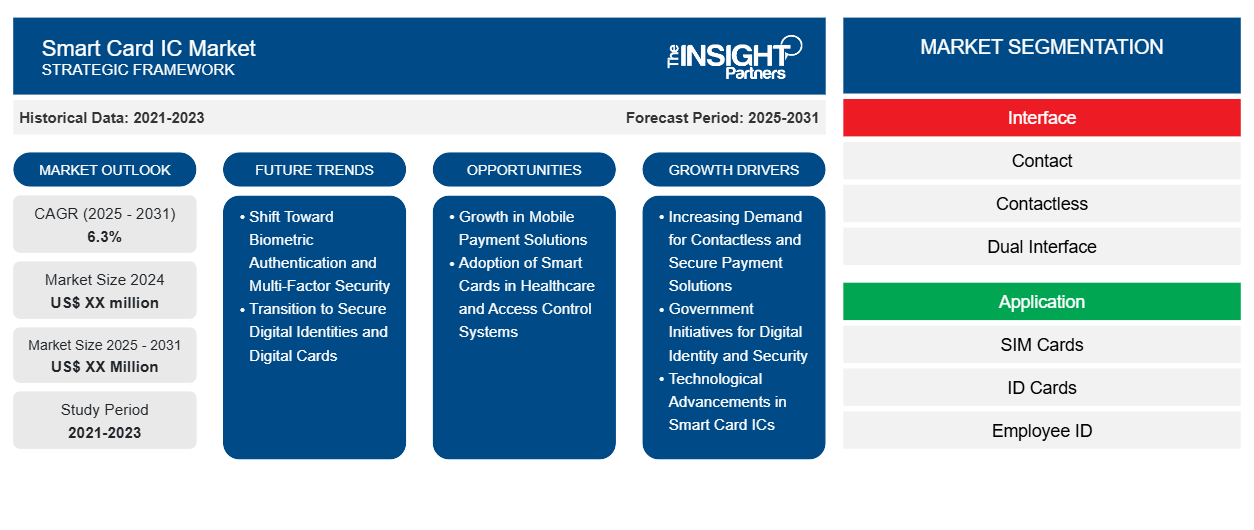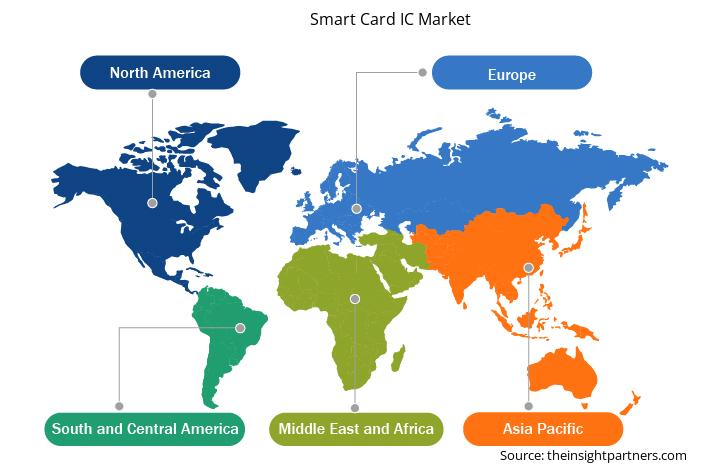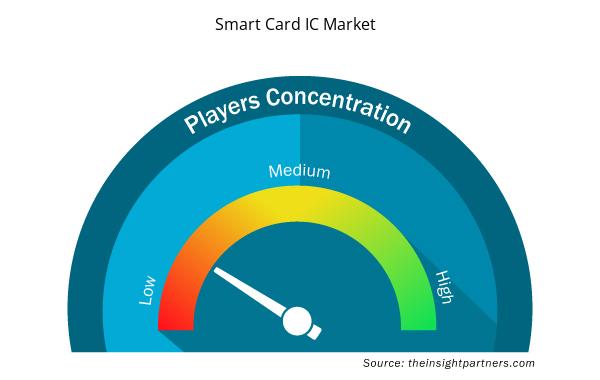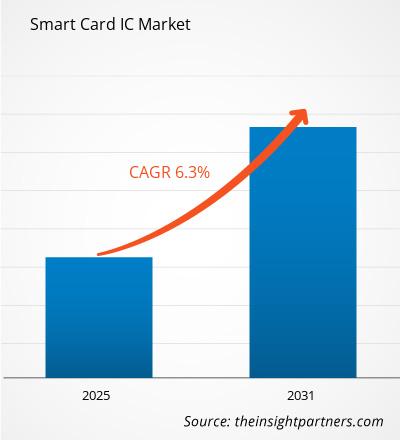The Smart Card IC Market is expected to register a CAGR of 6.3% from 2025 to 2031, with a market size expanding from US$ XX million in 2024 to US$ XX Million by 2031.
The report is segmented by Interface (Contact, Contactless, Dual Interface); Application (SIM Cards, ID Cards, Employee ID, ePassport, loT Devices, Others); End-User (Telecommunications, BFSI, Government and Healthcare, Transportation, Others). The report offers the value in USD for the above analysis and segments
Purpose of the Report
The report Smart Card IC Market by The Insight Partners aims to describe the present landscape and future growth, top driving factors, challenges, and opportunities. This will provide insights to various business stakeholders, such as:
- Technology Providers/Manufacturers: To understand the evolving market dynamics and know the potential growth opportunities, enabling them to make informed strategic decisions.
- Investors: To conduct a comprehensive trend analysis regarding the market growth rate, market financial projections, and opportunities that exist across the value chain.
- Regulatory bodies: To regulate policies and police activities in the market with the aim of minimizing abuse, preserving investor trust and confidence, and upholding the integrity and stability of the market.
Smart Card IC Market Segmentation
Interface
- Contact
- Contactless
- Dual Interface
Application
- SIM Cards
- ID Cards
- Employee ID
- ePassport
- loT Devices
End-User
- Telecommunications
- BFSI
- Government and Healthcare
- Transportation
Geography
- North America
- Europe
- Asia Pacific
- Middle East and Africa
- South and Central America
Customize This Report To Suit Your Requirement
You will get customization on any report - free of charge - including parts of this report, or country-level analysis, Excel Data pack, as well as avail great offers and discounts for start-ups & universities
Smart Card IC Market: Strategic Insights

- Get Top Key Market Trends of this report.This FREE sample will include data analysis, ranging from market trends to estimates and forecasts.
Smart Card IC Market Growth Drivers
- Increasing Demand for Contactless and Secure Payment Solutions: One of the primary drivers of growth in the smart card IC market is the increasing demand for secure and contactless payment solutions. With the rise of digital payments and the shift towards cashless transactions, there is a growing need for secure and efficient methods to process payments. EMV (Europay, MasterCard, and Visa) smart cards, which use embedded chips for secure transactions, have become the standard for financial transactions worldwide. The demand for contactless payment cards, which use RFID technology to enable faster and more convenient payments, is growing, especially in regions like Europe, North America, and Asia-Pacific. Smart card ICs are integral to the security features of these payment solutions, including encryption, authentication, and fraud prevention, thus driving the market for secure payment technologies.
- Government Initiatives for Digital Identity and Security: Governments worldwide are adopting digital identity solutions and secure access control systems to enhance public services and improve security. Smart cards are increasingly being used for identity verification, including in national ID programs, e-passports, driver’s licenses, and voter ID cards. In countries like India, China, and several European nations, governments are implementing smart card systems to streamline citizen services, improve data security, and ensure efficient public administration. This growing reliance on smart cards for government applications is driving the demand for smart card ICs, as they are key components that enable secure storage and management of personal data.
- Technological Advancements in Smart Card ICs: The advancements in smart card IC technology have contributed to the growth of the market. Over the past decade, the performance, security, and functionality of smart card ICs have significantly improved. For instance, the incorporation of microprocessors, multi-application capabilities, improved encryption algorithms, and advanced authentication methods (such as biometrics or two-factor authentication) into smart card ICs has increased their use across various sectors, including healthcare (for medical records and prescriptions), telecommunications (for SIM cards), and transportation (for fare collection and access control). Additionally, the integration of IoT capabilities in smart card ICs is expanding their functionality, further driving the adoption of these cards in various sectors.
Smart Card IC Market Future Trends
- Shift Toward Biometric Authentication and Multi-Factor Security: As security concerns continue to rise, there is a noticeable trend toward integrating biometric authentication (such as fingerprint scanning, facial recognition, and iris scanning) with smart card systems. This is particularly important for applications where high levels of security are required, such as banking, government-issued identity cards, and corporate access control systems. Smart card ICs are evolving to support biometric data storage and processing, creating a more secure and seamless user experience. Multi-factor authentication, which combines something you have (smart card) with something you know (PIN) or something you are (biometric), is becoming increasingly popular in both consumer and enterprise applications, driving the evolution of smart card ICs.
- Transition to Secure Digital Identities and Digital Cards: The market is witnessing a trend towards digital transformation in the identity and payment sectors, with digital smart cards gaining prominence. Digital versions of physical smart cards, such as those stored in mobile devices or digital wallets, offer the same functionality but with added convenience. This trend is particularly strong in banking and telecom sectors, where consumers are increasingly using digital versions of their payment and SIM cards. The integration of smart card ICs into digital identity systems, enabling secure access to services online (such as government portals, e-commerce, and financial services), represents a significant opportunity for market growth. This shift is being driven by the rise of mobile-first solutions and secure authentication systems.
Smart Card IC Market Opportunities
- Growth in Mobile Payment Solutions: The rise of mobile wallets and mobile payments presents a significant opportunity for the smart card IC market. Technologies like NFC (Near Field Communication) and embedded secure elements (SEs) are being integrated into smartphones to enable secure mobile payment solutions. Smart card ICs, particularly those used in SIM cards and embedded secure elements within mobile devices, are crucial for ensuring the security and authenticity of mobile transactions. As mobile payments grow, especially in emerging markets where mobile phone penetration is high but banking infrastructure is still developing, there is a growing opportunity for smart card IC manufacturers to supply components that power these secure mobile payment systems.
- Adoption of Smart Cards in Healthcare and Access Control Systems: Healthcare is one of the key areas where the smart card IC market is poised for growth. Smart health cards are being used to store patient information securely, facilitating easier access to health records, prescription management, and even payments for healthcare services. In addition, access control in buildings, campuses, and workplaces is increasingly relying on smart cards for secure entry. Smart card ICs used in access badges and employee ID cards for secure identification and access management are in high demand across sectors such as corporate offices, government buildings, universities, and hospitals. With growing emphasis on physical security, the market for smart card ICs in access control and healthcare will continue to expand.
Smart Card IC Market Regional Insights
The regional trends and factors influencing the Smart Card IC Market throughout the forecast period have been thoroughly explained by the analysts at Insight Partners. This section also discusses Smart Card IC Market segments and geography across North America, Europe, Asia Pacific, Middle East and Africa, and South and Central America.

- Get the Regional Specific Data for Smart Card IC Market
Smart Card IC Market Report Scope
| Report Attribute | Details |
|---|---|
| Market size in 2024 | US$ XX million |
| Market Size by 2031 | US$ XX Million |
| Global CAGR (2025 - 2031) | 6.3% |
| Historical Data | 2021-2023 |
| Forecast period | 2025-2031 |
| Segments Covered |
By Interface
|
| Regions and Countries Covered | North America
|
| Market leaders and key company profiles |
Smart Card IC Market Players Density: Understanding Its Impact on Business Dynamics
The Smart Card IC Market market is growing rapidly, driven by increasing end-user demand due to factors such as evolving consumer preferences, technological advancements, and greater awareness of the product's benefits. As demand rises, businesses are expanding their offerings, innovating to meet consumer needs, and capitalizing on emerging trends, which further fuels market growth.
Market players density refers to the distribution of firms or companies operating within a particular market or industry. It indicates how many competitors (market players) are present in a given market space relative to its size or total market value.
Major Companies operating in the Smart Card IC Market are:
- Microchip Technology
- Broadcom
- NXP Semiconductors
- ON Semiconductor
- HID Global Corporation
- Bombardier
Disclaimer: The companies listed above are not ranked in any particular order.

- Get the Smart Card IC Market top key players overview
Key Selling Points
- Comprehensive Coverage: The report comprehensively covers the analysis of products, services, types, and end users of the Smart Card IC Market, providing a holistic landscape.
- Expert Analysis: The report is compiled based on the in-depth understanding of industry experts and analysts.
- Up-to-date Information: The report assures business relevance due to its coverage of recent information and data trends.
- Customization Options: This report can be customized to cater to specific client requirements and suit the business strategies aptly.
The research report on the Smart Card IC Market can, therefore, help spearhead the trail of decoding and understanding the industry scenario and growth prospects. Although there can be a few valid concerns, the overall benefits of this report tend to outweigh the disadvantages.
- Historical Analysis (2 Years), Base Year, Forecast (7 Years) with CAGR
- PEST and SWOT Analysis
- Market Size Value / Volume - Global, Regional, Country
- Industry and Competitive Landscape
- Excel Dataset



Report Coverage
Revenue forecast, Company Analysis, Industry landscape, Growth factors, and Trends

Segment Covered
This text is related
to segments covered.

Regional Scope
North America, Europe, Asia Pacific, Middle East & Africa, South & Central America

Country Scope
This text is related
to country scope.
Frequently Asked Questions
Some of the customization options available based on the request are an additional 3–5 company profiles and country-specific analysis of 3–5 countries of your choice. Customizations are to be requested/discussed before making final order confirmation# as our team would review the same and check the feasibility
The report can be delivered in PDF/PPT format; we can also share excel dataset based on the request
Shift toward biometric authentication and multi-factor security and transition to secure digital identities and digital cards is likely to remain a key trend in the market.
Increasing demand for contactless and secure payment solutions, government initiatives for digital identity and security, and technological advancements in smart card ICs are the major factors driving the smart card IC market.
Global smart card IC market is expected to grow at a CAGR of 6.3% during the forecast period 2024 - 2031.

 Get Free Sample For
Get Free Sample For